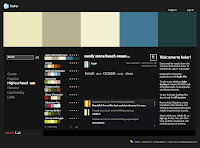 Struggling to design appealing and effective color palettes can be one of the most difficult challenges a graphic designer faces in the course of developing a project. When existing collateral or brand systems leave palette options wide open, it is often challenging to get started with meaningful color exploration.
Struggling to design appealing and effective color palettes can be one of the most difficult challenges a graphic designer faces in the course of developing a project. When existing collateral or brand systems leave palette options wide open, it is often challenging to get started with meaningful color exploration.Thankfully Adobe Labs has stepped up to the challenge. They recently introduced Kuler, an online application that helps designers create 5-swatch color systems based on a variety of mathematic rules.
 Starting with a single primary color – easily derived or established by even the most remedial comp – Kuler's seven rules help define four complimentary colors and create a usable color palette. Of course, users can manually edit these automatic selections or create their own palette from scratch.
Starting with a single primary color – easily derived or established by even the most remedial comp – Kuler's seven rules help define four complimentary colors and create a usable color palette. Of course, users can manually edit these automatic selections or create their own palette from scratch.And once a color palette is created, it can easily be exported as an Adobe Swatch Exchange (.ase) file, usable by any of Adobe's Creative Suite 2 or 3 applications (notably, Photoshop, Illustrator, and Flash). The palettes can also be named and shared with Kuler's community of designers.
The result of a great online tool that helps designers quickly generate systematic and complimentary color palettes that can shared quickly among designers and their applications. Kuler speeds up the design process and – and it's fun to play with.
Kuler is available in both a browser-based version built with Flash and a desktop version running on the Adobe AIR runtime.





